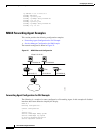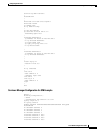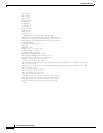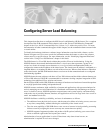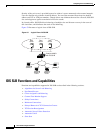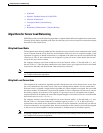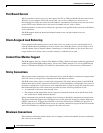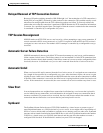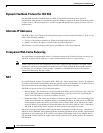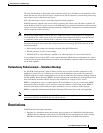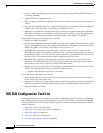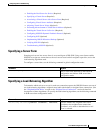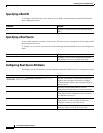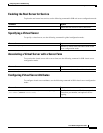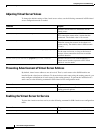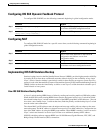
Configuring Server Load Balancing
IOS SLB Functions and Capabilities
IPC-138
Cisco IOS IP Configuration Guide
Dynamic Feedback Protocol for IOS SLB
The IOS SLB Dynamic Feedback Protocol (DFP) is a mechanism that allows host agents in
load-balanced environments to dynamically report the change in status of the host systems that provide
a virtual service. The status reported is a relative weight that specifies the capacity of a host server to
perform work.
Alternate IP Addresses
IOS SLB enables you to Telnet to the load-balancing device using an alternate IP address. To do so, use
either of the following methods:
• Use any of the interface addresses to Telnet to the load-balancing device.
• Define a secondary IP address to Telnet to the load-balancing device.
This function is similar to that provided by the LocalDirector (LD) Alias command.
Transparent Web Cache Balancing
You can balance transparent Web caches if you know in advance the IP addresses they are serving. In
IOS SLB, configure the IP addresses, or some common subset of them, as virtual servers.
Note A Web cache can start its own connections to real sites if pages are not available in its cache. Those
connections cannot be load balanced back to the same set of caches. IOS SLB addresses this situation
by allowing you to configure “client exclude” statements so that IOS SLB does not load balance
connections initiated by the Web caches.
NAT
Cisco IOS Network Address Translation (NAT), RFC 1631, allows unregistered “private” IP addresses
to connect to the Internet by translating them into globally registered IP addresses. Cisco IOS NAT also
increases network privacy by hiding internal IP addresses from external networks.
IOS SLB can operate in one of two redirection modes:
• Directed mode—The virtual server can be assigned an IP address that is not known to any of the real
servers. IOS SLB translates packets exchanged between a client and real server, translating the
virtual server IP address to a real server address via NAT.
• Dispatched mode—The virtual server address is known to the real servers; you must configure the
virtual server IP address as a loopback address, or secondary IP address, on each real server. IOS SLB
redirects packets to the real servers at the media access control (MAC) layer. Because the virtual
server IP address is not modified in dispatched mode, the real servers must be Layer 2 adjacent to
IOS SLB, or intervening routers might not be able to route to the chosen real server.
The main advantage of dispatched mode is performance. In dispatched mode, the Layer 3 and Layer 4
addresses are not modified, which means IP header checksum adjustment occurs quickly, and checksum
adjustment or recalculation for TCP or UDP is not required. Dispatched mode is also simpler than in
directed mode because packets for applications with IP addresses in the packet need not be examined
and modified.



